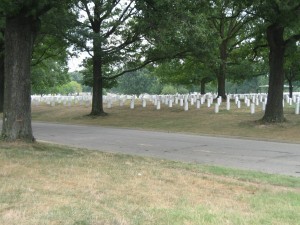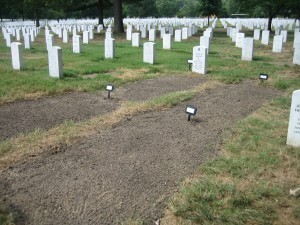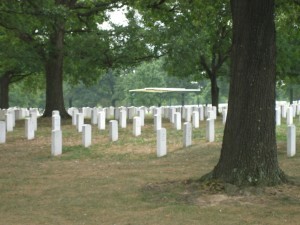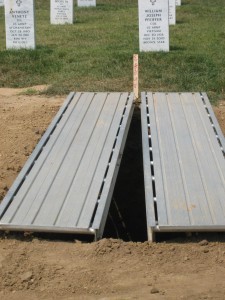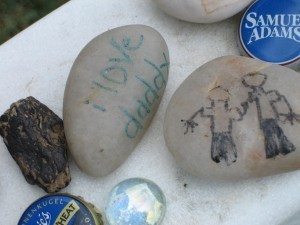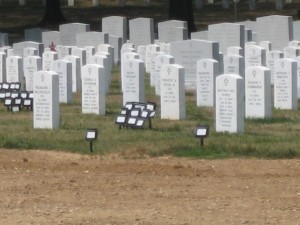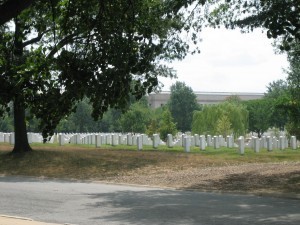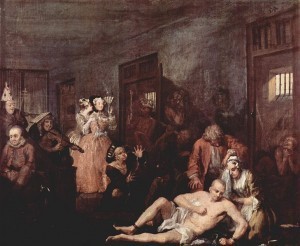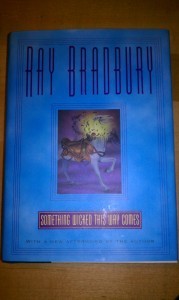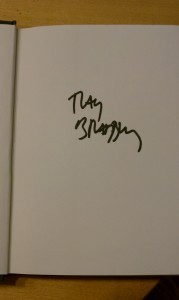Ilsa J. Bick's Blog, page 36
August 26, 2011
TIME FOR AN ASHES CONTEST!!
This is serious stuff, people. Go. Enter. WIN!!
August 8, 2011
The Saddest Acre
It's been called the nation's saddest acre, but it is much larger, an ocean of orderly white headstones and black markers. It is also a very quiet place; you have to know where you're going and what you're looking for because so many people do not come here. From the parking lot, a steady river of tourists flows up the hill toward Robert E. Lee's Arlington House where the flag always seems to fly at half-staff these days. Many tourists take blue and white, open-air tour buses which trundle past the more famous sites: Kennedy's grave, the Tomb of the Unknowns, the memorials to both the Challenger and Columbia astronauts. There's a relatively new memorial dedicated to America's service-women where school kids have left notes and pictures
and there's a very nice series of exhibits detailing a quick, thumbnail history of women in the military.
And, of course, there are memorials and graves: the remains of over 320,000 servicemen and women, veterans from every war and conflict in U.S. history.
If you do go to Arlington National Cemetery and decide that you could do with a reminder of sacrifice that is real and immediate, then hang a left out of the visitor's center and walk ten minutes or so down Eisenhower Drive (and get a fine view of the Air Force memorial),
past the McClellan gate rearing up on the right,
and then left down York, where they're also doing a little construction.
There's no mistaking Section 60, not only because it's marked but the ground of the most recent burials is still raw and brown, and there are a lot of them.
The awnings are a giveaway, too, because of the number of burials going on and how hot it's been in D.C. this summer.
Down here, where the most recent graves are, the grass hasn't grown back yet, and things are . . . freer. Arlington is orderly and pristine everywhere else, although some headstones are much more elaborate and what you'd expect from a cemetery.
Section 60, though, is different.
It's the newness for one, all that raw, brown earth and the aluminum caps that cover the freshest, empty rectangles that have yet to be filled.
For another, this area is a little on the messy side, and that's fine because life isn't tidy and neither is death. Section 60 is very personal. There are pebbles on headstones and glass and bottle caps. There are pictures and balloons, fresh flowers and rubber duckies, dog tags and prayer beads, stones onto which a child has scrawled a message to his dad.
And there are mourners.
I couldn't bring myself to photograph them in their grief because that felt like an invasion. Stephen Crowley did a fine series for the New York Times that's worth your time.
One thing I noticed: a lot of the guys who visited squatted down and then covered their mouths. I don't know why that is. I imagined that maybe they were holding something back—maybe a sob or a scream. I got pretty emotional, so I can only imagine the horror, pain, and grief someone must feel when visiting a son or brother, a buddy or childhood friend.
A few of the headstones gave me pause, too, the larger ones which mark where those killed on the same day or in the same operation or vehicle rest. They're a little weird—I'm not criticizing; I'm just saying—because you read everything from helicopter mishap to helicopter crash and you have to wonder what the hell's the difference. The end is the same.
There are other remains here, too: soldiers who served in Vietnam and Korea, WWII. Maybe it's to save space, but those who died together or served in the same outfit are memorialized together, as with this cluster of black temp markers.
Having read stories of people who visit and read poetry and books to the dead . . . I used to think that was just a little bit strange. But I spent a fair amount of time in Section 60 and leaving was very hard just as writing this is tough, too. I don't know any of those people. Or, maybe, I did and do. Maybe there's a man or woman I saw during my time in the Air Force, someone who served during Desert Storm and went on to serve during OED (Operation Enduring Freedom/Iraq) or OND (New Dawn in Afghanistan). Lingering and getting choked up then—and at this moment—seems so small, not even the least I can do because nothing will ever be enough. This is one debt that can't be repaid. You can only be respectful and allow yourself to remember that Arlington isn't just about history. Arlington is very much in the now: this hour, this moment, the minute that just went and the day yet to come.
So, next time you're in D.C., do yourself a favor. Go pay your respects to the best dad, the world's greatest mom, the most beloved husband, the most treasured wife, the bravest daughter, the most courageous son. Take a couple seconds or a good hour. Next time you read about something like those troops killed in Afghanistan a few days ago or hear about a kid from your town who died, take some time to reflect.
Because life is precious; the times of our lives are valuable and so fleeting—and theirs, on this earth, is done.
July 31, 2011
July 2011 Reads, Listens and Looks
Astute observers will notice that I didn't post an entry last weekend. Instead, I went 5+ hours north to the area around Houghton, MI for a brief survivalist refresher course. Now, Houghton is nothing like ASHES' Waucamaw Wilderness, although I have to admit that I wasn't sure what to expect, having never been to the town. Thanks to one of my recommended listens, the ride up and back was pleasant enough. I remember that when I moved here, a colleague who hailed from Iowa said that I would discover the joys of the road trip: "That's what people do in the Midwest: they get in their cars and drive." To be truthful, I'm not one for driving much, although I like cars and, depending on my mood, indulge in some serious car envy whenever a vintage show comes to town. (On the way north, I passed a classic resale place and–I'll admit it–the impulse to pull off the road was almost overwhelming.)
As it happened, I did pull over but not there. Sunset was an hour away and I was, maybe, fifteen minutes out of town. I'd just passed through the Ojibwa Recreation Area, emerged from the trees–and there, spreading out before me, was Keweenaw Bay–glassy and calm–and, beyond, the greater expanse of Lake Superior. The view was so breathtaking, I simply pulled over, killed the engine and let the silence come down.
Houghton was pleasant, too. I expected a one-stop light kind of place: a couple burger joints, a gas station, a bar on each of the town's four corners. Well, Houghton was a (pleasant) surprise. The town's nestled in hills along the Portage Waterway. Michigan Technological University calls the town home and . . . and has frats. And what looked like a couple sororities. The downtown area's nice, if you're into that.
But Houghton, like some many of the Yooper's towns, is dwarfed by the wilderness which surrounds it. Five minutes out of town and you're into woods, hills, lakes. Loons.
I sure hope the folks up there know what they have. Superior is my favorite of the Great Lakes because it is, and feels, so remote. You don't have to travel far to lose people, go tramping or simply find a good place to sit still.
Oh, and in case you're wondering . . . yes, the trip was well worth it and, yes, I clearly survived. My teacher, David, was incredibly hands-on and everything you'd want in an instructor: patient, flexible, skilled, interested only in making this an experience that benefited me and not some pre-set agenda. (If you're ever in the area, do check out what he has to offer. Well worth your time.) The good news: Not only was I (once more) reassured that I did/do know what I'm doing most of the time, I picked up a coupla tricks that I know will find their way into a novel. The bad news: I still can't get that damn bowdrill to work. The fact that David couldn't either made me feel marginally better. I suppose if I had infinite arm strength and a long, long time . . . I could do it. Maybe. Yeah, I'm sure I could. Right now, all I get is smoke, which sucks. Some day . . .
And, yes, for those of you who commented on "Gear Girl" and the infamous JetBoil: got a new one in the nick of time, brought it along and had my morning cuppas. They were more comforting than I can say.
On to the business at hand:
READS
Johnson, Maureen. (Putnam Juvenile, 2011). I already mentioned in another post that I scored this ARC at the ALA and all thanks to the kindness of strangers. The first in a trilogy, the book follows Rory Deveaux, a Louisiana transplant doing a year at a London boarding school, who–thanks to a near-death experience–can now see ghosts. The plot's pretty simple, actually: there's a Jack-the-Ripper copycat loose in London and, natch, only Rory and a select few who make up a secret police force can see him. There's no real mystery here, and many of the plot turns and events were predictable but what really saves this book and makes it immensely readable and quite enjoyable is Rory's voice–funny, incisive, a tad biting–and Johnson's talent for place as well as her ear. You hear her characters and that is half the battle for any writer. Oh, and the adults? Behave like adults. You gotta love that.
Peacock, Doug. Grizzly Years: In Search of the American Wilderness (Henry Holt, 1996). Anyone interested in conservation knows Peacock's story. Fresh from the Vietnam War where he served two tours as a Green Beret medic, Doug Peacock is a young man with more than his share of spiritual wounds. Like so many others, his life became a boozy, self-destructive downward spiral. What saved him was the wilderness and, more specifically, grizzlies. This book follows his spiritual rebirth–the bears he studied and filmed, the ones he didn't kill, the trauma he finally vanquished, the life path he has chosen in his fight to save these creatures. In the bear, Peacock has found a metaphor for the fragility and majesty of a vanishing wilderness. Bring Kleenex.
Sandford, John. Buried Prey (Putnam, 2011). Although Sandford's one of my favorite writers, I've found the last few entries of his Prey series kind of flat. At first, I chalked it up to his starting the new Virgil Flowers series (one which has to grow on you, I think) and then to exhaustion. Buried Prey is his 21st novel featuring Lucas Davenport and even a writer as inventive as Sandford must be running out of tricks. So I wasn't expecting a great read, just a good one.
I was wrong–and I'm so glad.
Buried Prey revolves around the discovery of two girls, long dead, who'd disappeared way back in 1985 when Lucas was still a patrol cop. The murderer was ostensibly caught, but Lucas had never been satisfied with the way it all went down. The novel is divided into two parts, past and present, and I have to say that I loved revisiting the characters and relationships that made me fall in love with Sandford in the first place. Forget the murder mystery, although it's quite good and very believable and–in its own way–a little pathetic. After all, what happens to killers as they age? What Sandford rediscovers by looking back is the freshness that's been missing from some of his latest efforts and, to a degree, his Virgil Flowers series. It's not necessarily the mysteries or shoot-outs or sheer number of characters that drive a story. Sandford's work is always at its best when he gives Lucas his life, not simply a series of (somewhat interchangeable) people who trot in and out of the narrative. I will say that there was only one major disappointment here, and that revolves around who dies. You see it coming a mile away. My fantasy is that this will somehow change Lucas, though–not into winding down and pulling back–but getting right back into the mix. The BCA was a necessary move, but Lucas belongs on the streets and in the trenches.
I also find it fascinating that, this year, both Sandford and Lee Child have chosen to go back in time with their characters. Child's book, The Affair, isn't due for another two months (wah!), but these writers might be responding to the same impulse: we are who we've known.
LISTENS
Naylor, Sean. Not a Good Day to Die: The Untold Story of Operation Anaconda (narrated by John Henry Cox; Sound Library, 2005). Anyone who's been awake for the last, nearly ten years remembers this. Anaconda was the first large-scale U.S. joint military and paramilitary CIA operation in Afghanistan to involve both Special Forces and regular units working in cooperation with allied Afghan, NATO and non-NATO forces against the Taliban–and it was supposed to be a cakewalk, given the U.S.'s military might. Designed to root out Taliban from the Shahi-Kot Valley and Arma Mountains, the operation instead became a rout of the U.S. military–a case-study for what not to do when marshalling disparate forces in unfamiliar terrain. To my mind, the Battle of Takur Ghar, renamed the Battle of Roberts Ridge after the Navy SEAL who was the first casualty, is all about the take-home: all the fancy machines in the world won't help you against a determined, entrenched enemy on his home-turf. An operation that began as an assault turned into a rescue mission that lasted less than twenty-fours, resulted in an obscene number of casualties and the deaths of eight U.S. soldiers, including AF PJ (pararescue jumper) Jason Cunningham. Mortally wounded, Cunningham continued to direct care of the wounded as long as he could–saved ten soldiers, got the bodies of seven more back home–and for his actions was posthumously awarded the Air Force Cross, second only to the Medal of Honor. (And which, given his actions, makes you wonder why his award has never been upgraded. If you think the Rangers and SEALS are tough, go learn about this very elite unit. PJs are braver than brave.) Although there's a lot to keep track of in this book and it's not always easy to visualize what's happening where . . . well, welcome to war. Naylor's book is a testament to American arrogance and soldiers' sacrifice. And did no one remember what happened to helicopters in the First Persian Gulf War? The sand did them in.
Sandford, John. Buried Prey (narrated by Richard Ferrone; Penguin Audio, 2011). Yeah, I'm like that: books I really enjoy, I read and listen to, sometimes at the same time, sometimes after I've listened (or read). This one I knew I wouldn't miss, no matter what. Ferrone is Lucas: always has been, always will be. This audiobook kept me company to and from Houghton. My only quibble? It ended while I was still an hour out from home.
LOOKS
I saw no movies this past month. No, wait. I take that back. I saw one but only the first half was any good. The entire second act devolved into a treacly quasi-Spielbergian debacle and homage to E.T. . . . and can you guess which movie I'm talking about? So I'm not going to bother reviewing it because if you can't say something nice . . .
And I watched virtually no television.
Whoa. There is something seriously wrong with the universe.
July 17, 2011
Gear Girl
I have a confession to make.
I am a complete gear girl. Complete. And I got it bad, enough so there ought to be a support group for people like me. Because when I fall off the wagon, I fall hard.
Let me explain.
A couple of weeks ago, I was in the market for a new sleeping bag with the idea of going out for a day here, a night there. Sleeping in the backyard just because, or maybe stealing a friend's pass to this very nice camp out on Lake Michigan and hanging for a night of peace and quiet. Nothing heavy, but I wanted to be out long enough where my much-older, much heavier-weight sleeping bag was just so unappealing. (And forget about packing it for any distance. Blah.)
I'll also be straight-up in saying that summer is NOT my favorite time to hang in the woods. Hot, humid, mosquitoes, noseeums, biting flies . . . blah. Hiking isn't bad so long as you drown yourself in DEET, and you always know when it's time to apply more because after two hours? There's that little whine just off to your left . . . I swear, there was one year where the hubby and I hiked this pretty remote inland valley and lake area and the mosquitoes were so thick they came in clouds. First year I was ever glad I'd bought that silly mosquito net.
So, sleeping out in summer is not something I routinely do unless I'm in a REALLY nice tent–and since the hubby just isn't into that anymore, I usually have to borrow my friend's much bigger, much bulkier dome and it's simply not worth the effort.
Anyway. I needed a new bag for this coming weekend, but here's the thing. I'm as dangerous in places like Gander Mountain and Erehwon as I am in a bookstore. If there's one theory of the universe to which I subscribe it's this: a girl can never have too many books or survival knives. Or too much gear. And that pair of convertible pants looks pretty darned good, don'tcha think?
So I gave myself a budget and stern talking-to. Just the sleeping bag. Synthetic, not down despite the fact that the fill for a down bag means a much more comfortable night. I mean, we weren't talking DAYS on the trail and in survival shelters. And, okay, a sleeping pad to replace my ratty AF-issue pad from a bazillion years ago. As for the rest . . . blinders, girl, blinders, and you most definitely do NOT need another knife.
Three guesses how long that lasted.
Bags have advanced since I was in the market for a new one. Back in the dark ages and for people who weren't climbing, you know, Everest, it was sort of one-size fits all. (And, yes, that's how long ago I bought my first, trusty bag that has lasted lo' these many years.) But NOW. Wow. They have bags fitted for women. A total shock there. Before I knew it, I was fretting about things like color, if you can believe it. Like . . . oh, gosh, do I take the baby blue Marmot there or the jade green? (I ended up with green, which I justified by telling myself that, well, it was on sale. Rationalization is a wonderful thing.) I debated about the pads, too–inflatable! in different colors! like purple! my favorite!
Honestly.
I almost got away, too. But what I hadn't counted on were . . . the packs.
OMG.
Now, I have several packs: a few fanny packs of various vintages; several day packs; a couple around-town packs, and my HUGE, black bug-out bag. Yes, I could have emptied the bug-out bag and used that, but that sucker is ginormous and, you know, frameless. So it would be uncomfortable, even for a short-ish hike, don'tcha know. So, of course, I needed a new pack, right?
You can guess the rest.
I spent some time trying on packs, which have also advanced (something I knew since I have an uber-comfortable Sherpani daypack they don't make anymore for whatever reason–so I treasure that pack). For example, the Al2 frames are now completely enclosed. (In my misspent youth and YA-hood, everything was external. You know, those big honker Al2 frames that made it look like you were headed to the moon.) Of course, all these new packs were so comfortable and came in frames specifically designed for women AND in so many COLORS and SIZES . . .
I did resist, guys. I really did. Even though I found this pack that really spoke to me: a lovely Gregory Deva 60l, just purrfect for an overnight or weekend jaunt. I tried it on. I swooned. But I walked away. I really did.
Really.
Okay, okay, you got me. I walked away because all they had in the store was a medium frame, and I'm a small. Still. It's the principle of the thing, don't you think?
Heartsore, I trudged to the front with ONLY a bag and pad (inflatable, natch, and in such a nice shade of green)–and made the mistake of detouring through the gadget aisles. (And, okay, uncle, yes, I DID look at the knives. I know you'll be relieved that there wasn't a nice fixed blade in the bunch and I'm in the market for a Mora. Or maybe a K-Bar. I just can't decide and for now, my Ken Onion is fine for my purposes. Maybe. I'm not sure . . . )
Now, if there's one thing I just GOT to have in the morning, it's that first cup of coffee. I'd pretty resigned myself to instant because my only press is metal and just too bulky. Even with the new pack, I just couldn't justify bringing it along. Take up too much room with too little return.
Except . . . I discovered JetBoil.
O. M. G.
I will spare you my dropped-jaw, awe-factor. But whoever invented that sucker was a genius.
I did walk away, though, same as I had for that Gregory pack. My resolve lasted a good twenty-four, forty-eight hours, too. Then I broke down and found the Gregory on sale AND in my size. It arrived yesterday and I've already half-packed it and there's SO MUCH ROOM!
Surely . . . plenty of room for a JetBoil, don't you think? If I can find one on sale?
Right?
I know. Maybe I ought to lie down and wait for that to go away . . .
And speaking of which, crap, don't I need a nice, new inflatable camp pillow? That folds to the size of my fist?
But . . . of course.
Oh, the horror, the horror.
July 10, 2011
Close Encounters of the Undesirable Kind
By now, most people have heard/read/seen the story of that Yellowstone hiker who was mauled to death by a grizzly–and the Forest Service's decision to do nothing. While there are some folks out there who are pissed about this, the Forest Service made the right call, IMHO. Encountering a mother with her cubs isn't desirable any way you cut it, but the bear can't and shouldn't be faulted for doing what comes naturally: protecting her young.
As the ranger correctly points out, the more people there are in this or any park, the more likely they are to come into contact with a bear. Jack Olsen's fabulously compelling account of the deaths of two teenage girls, who were mauled by two different bears on the same night in Glacier back in 1967, is as relevant now as it was when the book first appeared in 1969, and worth a read. Some folks have trashed it for being all gushy-eco-environmental, but Olsen's points–specifically about how public opinion has so radically shifted from one of extermination to conservation–give one pause, especially when you consider just how few bears remain and how squeezed they really are. Because bears need a lot of space. A LOT, a lot.
Now I've come across bears, none of them grizzlies, a couple of times: some while in the car, some while standing on a porch condo, a couple while hiking. My close encounters on the trail have all been with yearlings as far as I can tell, and all black bears. Only once did we do something somewhat stupid–hung around, got a little closer with a bunch of other people to get a picture (yes, stupid, stupid; black bears get pissed, too) and then wandered back through the same area later–me singing at the top of my lungs–where, yes, the bear was still foraging. Dumb. We should've backed out. Dumb.
In hindsight, that particular bear had figured out we weren't a threat, and we were lucky. I would never do something so dumb again. I can't even plead ignorance because I do know better, but I happen to like seeing wildlife and bears, like wolves, can be tough to spot because they keep their distance. (Moose aren't afraid of you, but I stay VERY far away. Those things are huge and have a nasty temper. Get too close and it'll play the rumba on your head. Not pretty. For that matter, I yield to all wildlife. After all, I'm in their house and not only were they there first, they never invited me over for coffee and crumb cake.)
It's not that bears are cowards, but they're not eager to share space with you either, unless they're stressed, habituated to people and/or unable to locate a ready food source. The thing is, bears are eating machines; that's what they do and they eat most every minute of every waking hour. They're not that picky either, and once they've had a taste of garbage, your cans are toast. Last fall, we stayed at a place right outside Yellowstone and there was this grizz who happened by every night once it had a snootful of something I wouldn't have thought grizzlies would eat: poopy baby diapers. I'm serious.
There's all sorts of advice out there about what to do if you DO encounter a bear; the Daily Beast ran a article this past week on the subject. The Beast's advice is pretty good–although the conclusion, that this is unlikely to happen again, is dead-wrong. It WILL because more and more people are flocking to parks and doing really DUMB things (yes, like me, or deciding that, say, the gazillion-pound bison won't kick your silly head right off your shoulders if you get too close–and I actually saw this with my own beady little eyes: some old guy telling his wife to back up, c'mon, get closer, get closer, so I get you both in the shot) all but guarantees it.
Also, the one about not getting yourself into a situation where you might run into a bear? How practical is that? Hikers are frequently out there in the backcountry secretly hoping they will see that bear–at least from a distance. (Me . . . not so much. Through binoculars is close enough, thanks.) The advice about bear bells . . . well, take that with a grain of salt. From what I've heard, you might as well ring the dinner bell because while adults might stay away, CUBS are curious creatures and they'll make a beeline to see what's up. OTOH, to be honest, even I get tired of singing after a while and after you've hiked a good ten miles, you're not talking much either. And bells don't cost that much.
The other thing the article doesn't mention is how many people DON'T know how to use bear spray. Yes, there are directions, but do you know how much spray costs? About $50 a pop. Depending on the brand, once you've discharged the can, that's it. So you're talking a hundred bucks, easy: one can to practice with (watch the wind, too; that stuff blows back on you, now you're blind AND there's a bear about to eat you) and one to actually carry. I'm not complaining, just saying. In fact, I'm not against spray–far from it–but I am against throwing money away because you can't transport that sucker by air. TSA will confiscate it if they find it in your luggage and you really don't want to run the risk of the thing exploding in your luggage either. So that means buying a very pricey item you may never use–and leaving it behind.
So–memo to the Forest Service–rent cans of pepper spray. Bet you'd clean up, bring in much-needed revenue and make people safer all the way around, too, presuming they know how to use the spray and can deploy it in time and at the right distance. Discharge it too soon or into the wind, you're toast. OTOH, the Forest Service does have very good advice about the proper use and deployment of bear spray that's well worth the read.
Another thing the Beast article doesn't say: grizzlies frequently charge but stop. They have very bad eyesight. Very bad. If you're downwind, they may actually being charging to get close enough to make out what you are. Most experts advise standing your ground and, if you must, discharging your pepper spray at no greater distance than thirty or forty feet. (Me, I know all this intellectually but have never had to test the theory. I'm still not sure if I'd be calm enough, given the situation, to do the right thing–and, yeah, I hope never to find out.)
One thing that will help, though: learn to recognize bear sign. Scat, tracks, a grizzly dig. If you spot sign? Get the hell out. No view–no trip–is worth a run-in. There's plenty of wild country out there begging to be explored.
But do get out there. Enjoy nature. You're part of it, after all. Reconnect to magical places, like Yellowstone–or your nearest hiking path. Learn to share; learn your place–and stay safe.
July 3, 2011
June 2011 Recommended Reads, Listens and Looks
As promised, I'm combining my recommendations from the last two months. (Yes, I know; you've all been on pins and needles.) I've been a bit squeezed for time, and so my usual pace is a touch off. For example, I haven't seen a single movie! At. ALL. Which is just . . . wrong.
There is one saving grace to a lot of air travel, though: you read a bunch, especially when your flight's been delayed or you're sitting on a tarmac for several hours because of the monsoon that's suddenly begun or the lightening. So I plowed through a fair amount–and I have to say that certain airport storefronts, such as those from fabulous indie booksellers like Barbara's Bookstore and Simply Books, saved me from gnawing my nails to nubbins. So did the FANTASTICALLY AWESOME Flyleaf Books in Chapel Hill that I had to a chance to duck into after a wonderful breakfast with the staff at a small eaterie next door (herb biscuits to die for). I bought a TON of books–even after I'd broken down and gotten myself a Kindle just before jetting off, loading that sucker with five out-of-print books I just had to read. Now, I've had a Sony PRS 505 for years and years, but the battery is finally starting to go and then it was a choice between my phone's teeny-tiny screen or a new e-ink reader. I won't say that the Kindle has been AMAZING. It's no more or less amazing than the Sony, but it is convenient when traveling and I love being able to access public domain books from Google, Gutenberg and all that. (Yes, I could do it with my Sony, too, but the process was a bit torturous and the Sony is slower, a little clunkier.) So I brought along a fair amount of reading on the reader–but STILL opted for physical books when I saw them. Guys, there's nothing like a book. A real, tangible, physical book. There's nothing like a really good and inviting bookstore with a knowledgeable and enthusiastic staff. (Sarah, at Flyleaf, recommended just the BEST BOOK after I asked about something completely different. Said I'd love it. And–damn–she was right. I gobbled that sucker in four, five hours and have since passed on the love to another reader who is also enthralled–and that's because GOOD booksellers KNOW THEIR BOOKS!! KNOW VARIETY!! UNDERSTAND WHAT IT IS TO READ!!)
So bookstores rule. Period. End of story.
Okay, give me a sec to climb down from my soapbox; honestly, the next thing you know, I'll be standing in Speaker's Corner and mouthing off.
As for traveling and working, it's clear that I need to go back and review Kris Rusch's advice; she has this stuff–and so much more–down to an art.
At any rate, without further ado:
READS
Arnold, Catherine; Bedlam: London and Its Mad (Simon & Schuster UK, 2010). If this painting by William Hogarth is your idea of Bethlem Hospital
you're not alone. Having trained in an asylum with a long and illustrious history (even Dickens visited Hartford's Retreat–founded in 1822 and now The Institute of Living–during his first American tour and public access to mental institutions was common practice in the UK), I've always been interested in learning more about (the often notorious) Bethlem Royal Hospital. Its location has changed several times over, and the building Victoria would've known is now the Imperial War Museum which I've visited. Arnold's book is a fascinating look at the hospital's history, whose development mirrors changing conceptions, both legal and medical, on mental illness.
Brox, Jane; Brilliant: The Evolution of Artificial Light (Mariner Books; 2011). This is the book Flyleaf's Sarah suggested. It would NEVER have occurred to me to pick this up, but am I glad I did. Have you ever noticed how PANICKED people get when the lights go out? Brox has, and her points about how darkness was not as feared way back as it is now as well as concerns about the centralization of both the delivery of fuel (think gas works or electrical grids) and the loss of autonomy when such fuels were no longer available (or the delivery interrupted) was just fascinating. Light, as it happens, was for the wealthy because only the very wealthy could afford the high cost of good candles, the best whale oil, etc. Brox's writing is both lyrical and incisive, and her concerns about how the ready availability of light has removed us from the natural world are spot on. There are several wonderful anecdotes here, but my favorite is centers on 1994′s Northridge Earthquake outside LA. Emergency lines were flooded with calls about a bizarre, glittery cloud splashed across the night sky. And what was it? The Milky Way. Stories like that give you pause.
Connors, Philip; Fire Season: Field Notes from a Wilderness Lookout (Ecco; 2011). Jack Kerouac was so desperate for cigarettes that he smoked coffee grounds. Norman Maclean revelled in and wrote about the experience. Edward Abbey's 1971 novel, Black Sun, is based on his stints as a fire lookout. Now Philip Connors, who's spent the last eight years perched in the Gila Wilderness of New Mexico, has produced this book filled with his reflections as well as smatterings of history, biology and field notes. It's a short book, and some is quite redundant; other chapters read a bit like afterthoughts, something to beef up the narrative. Nonetheless, if you want a glimpse into a solitary occupation and lifestyle that is rapidly being lost to technology, this is a nice place to start.
King, A.S.; Please Ignore Vera Dietz (Knopf Books for Young Readers; 2010). I never would've picked this up save that it was up for the Edgar. This is a quirky, sometimes too cute but ultimately very interesting, fun and fine book that is only one part mystery and three parts character study. Vera's best friend, Charlie, has died under tragic circumstances, and only 17-year-old Vera knows the truth of what happened that night. While that's the crux of the mystery, that's not what will keep you turning pages. King's style is breezy; Vera's voice, ironic and full of both self-deprecating humor and loathing. There are some asides–the snarky ones from the Pagoda, for example–that feel unnecessary and Charlie's ghost pops up now and again to voice its opinion. But these little surprises are also what gives King's book its style and freshness.
Summers, Courtney; Fall for Anything (St. Martin's Griffin; 2010). It must've been my month for grieving teens. In this novel, Eddie Reeves is mourning the sudden suicide of her photographer dad. The absence of a note or any explanation are only a few of the roadblocks in Eddie's way to "getting over" her father's death. When one of her father's students enters the picture, the narrative takes a disturbing turn in this devastating exploration of grief and despair: when, sometimes, the only answer one will ever know is silence.
LISTENS
King, Stephen; Hearts in Atlantis (narrated by William Hurt and Stephen King; Simon and Schuster Audio, 2001). I admit it: I've listened to the first story in this very strange novel several times over. I will also admit that I have never listened to the novel all the way through, which is odd for me because King is a master storyteller even if the stories aren't always my cuppa. But I think I've been so captivated by the first tale–a novel in its own right, really–that I can't get past Hurt's expert narration of a story about young Bobby Garfield's friendship with and love for the much older, very mysterious Ted Brautigan. Hurt's reading is just that good, and I am in tears every single time I listen. If only I could figure out how to write half that well.
Simmons, Dan; Drood (narrated by Simon Prebble; Hatchett Audio, 2009). Okay, I'll admit it: I bought this doorstop of a novel when it first came out and just couldn't get into it. This was surprising, especially since I think Simmons' A Winter Haunting is a masterpiece and one I've read several times. On the other hand, I couldn't get into The Terror either. Still, I'm a Dickens fan of longstanding; I remember how upset I was when I realized that Dicken's unfinished The Mystery of Edwin Drood was the last book of his I would ever read! So when I saw that Simmons was tackling a fascinating period in Dickens' life–from the Staplehurt accident in 1865 to his death in 1870–I just couldn't resist, doorstop or not. Why? Because Dickens was clearly profoundly affected by the accident; only his carriage was spared, and Dickens suffered from what we'd recognize as PTSD for the rest of his life. Dickens had other problems during this time, too, not the least of which was the continuing stress following the dissolution of his marriage and his affair with the much-younger actress, Ellen Tiernan, with whom he'd been traveling at the time of the accident. His writing took a hit, too; after he completed work on Our Mutual Friend, he simply stopped penning novels, devoting himself instead to an intense series of readings in the U.S. and Great Britain. The toll this took on Dickens is well-documented not only in the more well-known biographies but also in George Dolby's account of these reading tours in Charles Dickens As I Knew Him: The Story of the Reading Tours in Great Britain and America, 1866-1870 . Dolby was Dickens' manager and this loyal friend's insights and descriptions are worth the read.
Simmons' conceit is "novel," too: a narrative told from the perspective of William Wilke Collins (author of such classics as The Moonstone and The Woman in White). Collins was a close friend and Dickens' collaborator for many years as well as a highly successful author in his own right. Collins was also a laudunum addict, and that gives a reader pause–because you simply don't know what or who to believe.
Still . . . I just couldn't get into it, and I think it's for the same reasons that this abridged listen works for me: there's just so much detail–much of it true, by the way–that this reads as well as almost any Dickens biography covering the same time period. While there are a few odd transitions that could've used smoothing over, this listen made me eager to try and tackle the book next. Again. When I have time  Seriously, this is a fine performance and Simmons' Collins is every bit a modern man.
Seriously, this is a fine performance and Simmons' Collins is every bit a modern man.
LOOKS
None. Nada. Zilch. No time and the weather's been nice enough that I'm not looking at DVDs much at the moment.
Which is sacrilegious. I got to get out more often. This month, for sure.
June 26, 2011
Chillin', Post-ALA
So I'm in Atlanta, hanging out, waiting for my flight back to Wisconsin (which is in, like, three hours) -and I figure it's good a time as any to share some personal ALA highlights and a few surprises. Goes without saying—but I'll say it anyway—that meeting people interested in what I've written, bloggers who've championed my work in the past and now, and readers so enthusiastic about ASHES the air fizzes—is just the best gift any writer could receive. When you spend so much time sweating over a hot keyboard in a little room and getting all emo about people who live in your head, it's so wonderful to be reminded that you're doing all this for a reason: to communicate, entertain, touch people and, sometimes, give them pause. Okay–and scare the bejesus out of them.
Highlight #1: TEAM ASHES reunion. Okay, it wasn't a HUGE deal or anything, but Katie Halata and Greg Ferguson are always so wonderful, so concerned about making sure things go well for ALL their authors. . . all authors should be so fortunate. (And for Mary Albi and Rob Guzman: You guys were missed. You, too, Doug.)
Highlight #2: Luke Vanderpool. I see you out there, scratching your head. You're thinking Luke who? He wrote what? For the record, I don't know if Luke writes or not, but I do know that he's the son of Clare Vanderpool who won the Newberry for the very excellent Moon Over Manifest. I just happened to plop myself down for a quick bite next to this young man, and I only really noticed him because he a) had an exhibitor's badge (so I'm, like, scoping out which author's with which house) and b) was reading a book. Now I had just read an interview in which Luke said something like Moon was a book his mom would totally write. His pride really shone through. So when I got up to go, I said something–how good his mom's book was–and he just beamed. "Yeah," he said, "it really is, isn't it?"
Moms around the world: this is the kind of son you kill for.
Highlight #3: ASHES cocktail reception: OMG, was that fun. Not only did we close the place down and stay WAAAAYYYY later than we should've, but I got to put faces to all these bloggers and readers and writers and fellow Twitterati—Em! Jenn! PJ! Cari! Christin! Jennifer! Lena! Stephanie! And a whole bunch more! Every single person I met was incredibly enthusiastic, gracious, SMART, giving . . . .not to mention extraordinarily well-dressed. (Green envy alert: Some of you ladies were lucky to leave with the dresses you came in.) I had such a blast. There was this one table of librarians– Sharon, Susan, Diana and Betsy–my goodness, we could've gabbed all night. And, yes, I got a chance to be the lady in red:
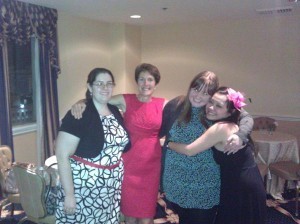
Highlight #4: So I'm on my way out after my two-hour ASHES signing–and we're talking straight, no letup, no down period, and no books left (and that really good-looking guy is my fabulous editor, Greg Ferguson)
and I decide to stop by Penguin to see if I can score a few ARCs. Well, unfortunately, the two I want aren't going to be up for grabs until the next day (today) and I knew I'm not going to be back because I really wanted to hit the National WWII museum, so it's like . . . bummer.
Well, these three women overhear. One, turns out, has met me at the BEA; the other two are very keen on ASHES, and one–Nancy–says, "So I'll get the ARCs and send them to you, no problem."
I'm just floored. I desperately want to say yes, but then the other, very polite part of me doesn't want to put anyone to any trouble.
Avarice wins. Need triumphs. I agree. But this is manus manum lavat, so I tell them to head over to the Egmont booth and score a couple ARCs.
So then I'm in the National WWII Museum (another highlight; I always get choked up when I read about soldiers and sacrifice and true courage, and I was fortunate enough to meet several vets who'd served back then and others who were in Vietnam), and then, all of a sudden, Nancy sends this text: she's gotten BOTH ARCs I'd wanted–a day early–and did I want to meet up?
Being floored–yet again–I explain where I am. We agree that they should drop them at the Egmont booth; then Nancy says all the ASHES ARCs are gone. Well, no sweat; these woman are not leaving without something–so I'll dig into my own stash once I'm home.
But. O. M. G. Talk about above and beyond–and complete kindness to a stranger. Made my afternoon.
Highlight #5: Major Melinda. I don't know her last name, but Melinda's a sister in blue: an AF major off to Afghanistan in a month. She came to the signing, and we chatted about getting books (both ASHES and DRAW) over to Afghanistan, which I know that both Egmont and Carolrhoda Lab will be sure to do. For me, Melinda was a reminder: those who serve deserve every ounce of support we can provide.
And Melinda: Stay safe. Stay in touch. I meant what I said.
Highlight #6: Dan Savage (see below).
Highlight #7: The YALSA Coffee Klatch was a BLAST and a half! Jay Asher as emcee! I'm breathing the same air as Maggie Stiefvater, Cassie Clare, Blythe Woolston, Claudia Gray (who knew a Desigual dress when she saw it). I mean . . . HELLOOOO.
So I was incredibly nervous. I mean, being a shrink, I can talk to almost anyone, but I need a little while to feel people out, have the conversation, that kind of thing. This was bam-bam-bam! Four minutes a pop. With forty authors and only an hour, this should've translated to, wuh, thirteen tables? Fourteen?
I think I got to about nine. We started late and y'know, I think they ended a tad early for pictures. Them's the breaks. But I had prepared. Spent the night before going over the points I wanted to get across (GAWD, thank you, PJ and Em; good marketing pointers, ladies). See, the Midwest is the perfect place for someone like me; we just don't go around tooting our own horns. I can talk to folks, but the lookit-me/listen-to-me thing is hard. So I practiced about twenty times. Woke up at 5 a.m., forced myself to stay in bed another hour, then jumped up, inhaled caffeine and practiced twice more.
Once I got started, though? It was FUN! Really! Mainly because everyone was really interested–or faked it really well. For the fakers out there: bless you, bless you; you have no idea how hard it is to do this kind of thing. I had a good time; people seemed enthusiastic; they were POLITE; they LISTENED and ASKED GOOD QUESTIONS (but with only five seconds left at the end of every spiel, most of the time I sort of hurled answers as I chased Claudia Gray away from my seat at the next . . . er . . . walked like the proper lady my mother would love to believe I've become to the next table). I would do a klatch again, in a heartbeat.
Highlight #8: Regina Griffin, from Egmont USA, is a hoot. She is also incredibly smart and exceedingly well-traveled. I'd never been able to spend much time with her, but she was thoroughly delightful AND an absolute pit bull when it came to hanging onto our table at Bon Ton (where we showed up mega-late after the cocktail party).
Highlight #9: I have a beer with my terrific Carolrhoda Lab editor, Andrew Karre. He's cut his hair. It's a buzz. I mistake him for a marine. Really. We talk books for about five minutes and spend the rest of the time discovering all we have in common. (Like, his brother was a percussion major at my alma mater, and Andrew used to play the French horn. For those who don't know? French horns turn on you. They're evil beasts.)
Highlight #10: Speaking of alma maters, I meet Tim Ditlow of Brilliance Audio, which is putting out ASHES on CD this September (and available through Audible as a download; DRAW will also come out on CD coincident with the paperback release at about the same time)–and discover he and I were in the same college at the same time and graduated in the same class! Did I know him then? No. Did he know me? No. But we know each other now. Hey, you take what you can get. (Goes without saying that I was so flummoxed, I couldn't remember which stupid year I graduated. Idiot . . . )
Highlight #11: A tweet where a fellow writer mentioned being too nervous to ask for a picture! Now, NO ONE has EVER wanted a picture of me. Well, I don't think. Anyway, Jamie, man, next time for sure!
Highlight #12: Harlan Coben looks exactly like his picture. Maybe that should be under surprises . . .
Highlight #13: I breathe the same air as Orson Scott Card. We're in the same room at the same time. His line is longer than G-d's (green envy alert, but he IS OSC), and I have to book. But still.
And some surprises:
1) Librarians know how to accessorize.
2) Librarians are not afraid to show off pink/green/rainbow/blue/whatever hair. They notice when you've got feathers in yours. (News flash: After two weeks and counting? My husband hasn't noticed at all.)
3) Librarians are fearless. Dan Savage's speech should count as a highlight, too, but his good humor and strength in the face of adversity–his passion to reach out to LGBT kids–was another choked-up moment.
4) I was both so exhilirated and so wrung-out, I didn't get to half the things I'd set my heart on. The time sped by incredibly fast, and then it was time to go.
So, nu, I'm gone. I'm in Atlanta. I have about twenty-four hours at home–time enough to pet the cats, do a couple errands that MUST get done (glasses for one kid, banking thing for another, cat food for the cats . . . sorry, but the hubby is on his own until he figures out about the feathers). Then I'm on the road again, this time to Chicago for a luncheon at Follett; then a flight to Charlotte and a luncheon on Wednesday at Baker & Taylor, followed by a drive to Raleigh and something else on Thursday . . .
And then I come home. For a while. This is good. After all, I always have another book to write 
June 19, 2011
Southeastern WI Festival of Books
So, it's raining like crazy; the day's turned dark and stormy; the temp's fifty-six (!). One soggy Father's Day, to be sure, but perfect for baking and resting up before the ALA next weekend.
Rest is what I need, let me tell you.
It was yet another busy week/weekend, with three events at the Southeastern WI Festival of Books. It was my first invite to this venue and would never have happened if not for my enthusiastic fan and friend, Laurie Van Tuinen, who not only gave me an entree to the program organizers but engineered a Skype-in w/ her book group, Oasis Readers.
I've been to cons, of course, and sat on panels. Still, other than academic venues, I'd never done a solo presentation–this one was on Apocalypse and Adolescence–and didn't know what to expect. Boy, was I nervous. Stayed up til near midnight figuring out how to hyperlink video to my slides. I was so keyed up, I popped awake at 4 a.m. on Friday. Mainlined caffeine. Made some last-minute obsessive changes to my slides. Triple-checked the video links. Made three copies on separate flash drives. Then puttered around the house. Did laundry. Drove the cats insane. Finally couldn't stand it anymore and got going for the festival a good three hours before my event. I know: early, especially considering that the venue was only an hour and a half away. But I figured on giving myself time.
Which was a good thing.
First, there was construction. Traffic snaked for miles and slowed to the point where I was seriously thinking about hoofing it the rest of the way. A ninety-minute trek turned into a two-hour+ marathon.
Second, when I did finally make it–and met two of the nicest women, Jennie Stoltz and Kathleen Eull, who'd done their very best to make me feel welcome before I even set foot in the place–we discovered that my laptop lacked the pin-port that would allow for a hook-up to the projector. Panic city. Not that I screamed or anything, but I was thinking that, well, this doesn't bode well . . .
But the tech guy, David Weber, was simply just the sweetest person. We futzed for three minutes and then he jetted home, yanked the HD cable from his Blu-ray, and we used that. David quite literally saved my bacon–and I'm a nice Jewish girl, too.
I worried no one would show for a 1 p.m. presentation on a Friday. But people did, and they asked fabulous questions. I also met Bob Marx, another local writer, who absolutely floored me when he gifted this signed copy of Bradbury's Something Wicked This Way Comes.
An afternoon panel with Swati Avasthi, Stephanie Kuehnert and Kathie Giorgio was flat-out fabulous. Packed room. Great audience participation. Thoughtful questions. Interesting, articulate reponses from my fellow panelists. I mean, what more can you ask?
On Saturday, there was yet another panel on writing SF/Fantasy and Horror with these guys: James Lowder, Matt McElroy, Stephen D. Sullivan and Alex Bledsoe (who does indeed live in the Mustard Capital of Wisconsin; I've always meant to swing past for a visit to that museum. There is NOTHING like a good mustard–on a brat, a cracker, a pretzel. YUM!). It was a thrill to be included with people who've been in the biz such a long time. War stories are always great learning opportunities, and these are guys who know what they're talking about, esp. since they're not only award-winners (and nany times over) but have been on both sides of the table as authors and editors and–in Matt's case, also as a publisher. Lots to learn.
There were other panels, of course, but I guess what I liked best was meeting and talking with attendees, other writers (Shawn McGuire and I finally meet!) and fans. For me, the stand-out moment was meeting Phil, a young man heading off to the Marines with his eyes open. That takes guts and a level of commitment you don't often see in a kid his age, and I'll say here what I said to him: Stay safe.
Signing books was fun, too, and the Bruces–Norm and Eve–who run Martha Merrill's Books & Cafe in Waukesha kept fans happy with plenty of selections. Norm was also the most enthusiastic, sweet guy you could ever hope to meet. Coached me through some jitters and did it well. The best part is they host author events for the love of books and so I'm thinking . . .
But, for now, it's time to kick back, relax, read, think about a synopsis for my follow-on to the novel I just wrapped up and bake the hubby a Tunnel of Fudge cake with oodles of chocolate–and a whole lotta love.
June 17, 2011
BEA Podcast
At the BEA, I had the good fortune to be interviewed about my inspirations for DRAW THE DARK. Les was a fabulous host/interviewer and was very good at curbing my natural verbosity.  I love talking books.
I love talking books.
Click below and enjoy!
New ASHES Video: Author Interview #1
The first of many, I hope. Enjoy!





